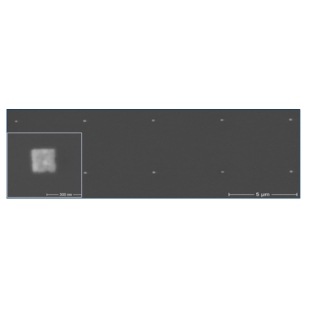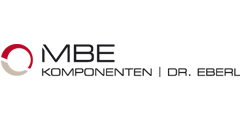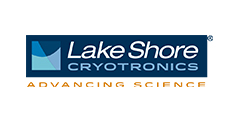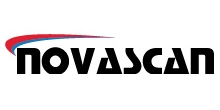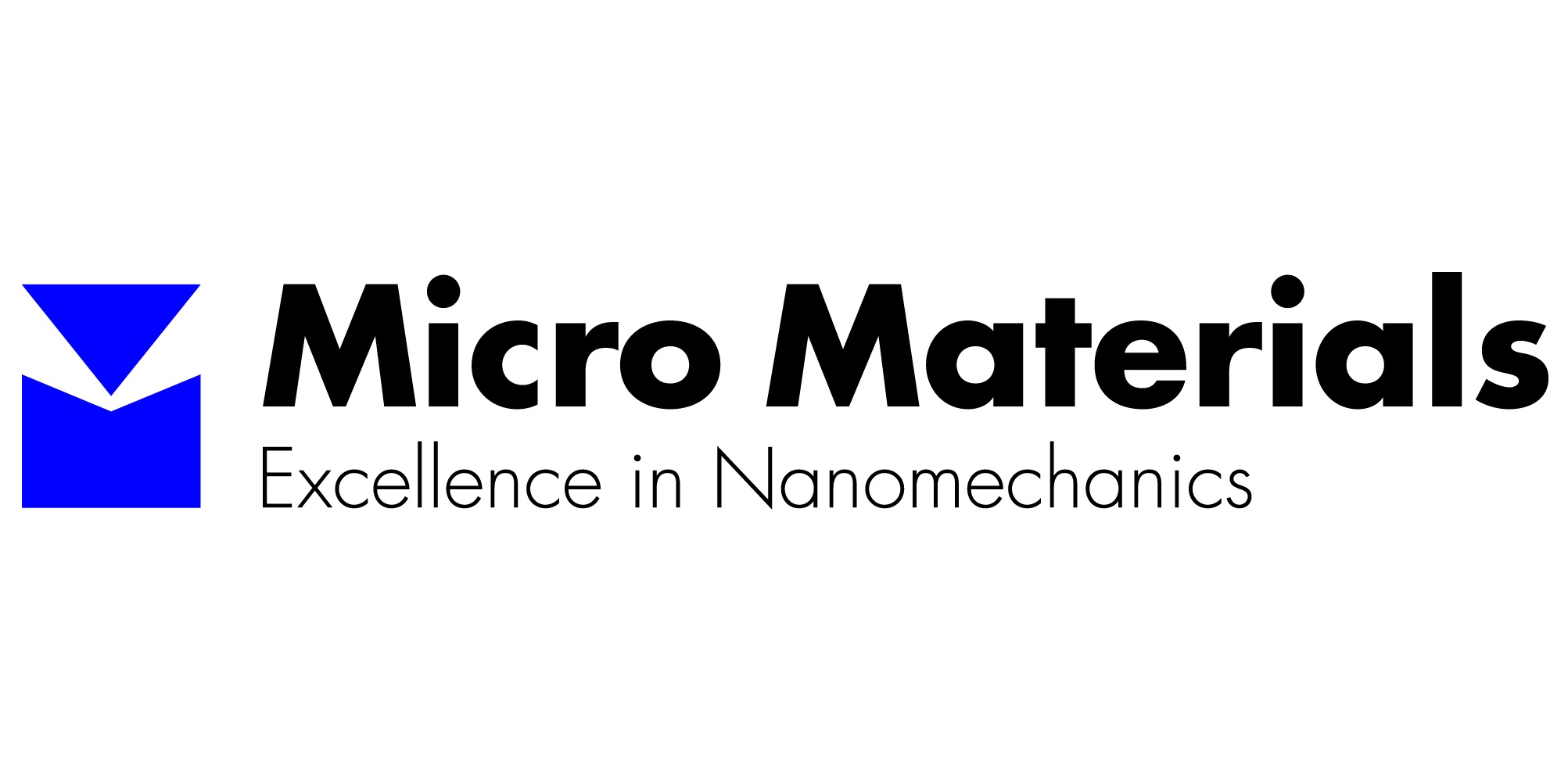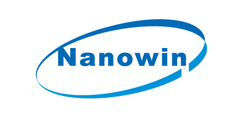详细介绍
产品详情
Protective Coating PMMA Electra 92 (AR-PC 5090)
Conductive protective coating for non-novolak-based e-beam resists
Top layer for the dissipation of e-beam charges on insulating substrates
英国ALLRESIST防护涂层PMMA Electra 92 (AR-PC 5090)
用于非氮基电子束电阻的导电保护涂层
用于在绝缘衬底上耗散电子束电荷的顶层
Characterisation 描述
- as protective coating, this resist is not sensitive to light / radiation
- thin, conductive layers for the dissipation of charges during electron exposure
- coating of non-novolac PMMA, CSAR 62, HSQ et al.
- longterm-stable and cost-efficient alternative to Espacer
- easy removal with water after exposure
- polyaniline-derivative dissolved in water and IPA
Conductivity 导电率
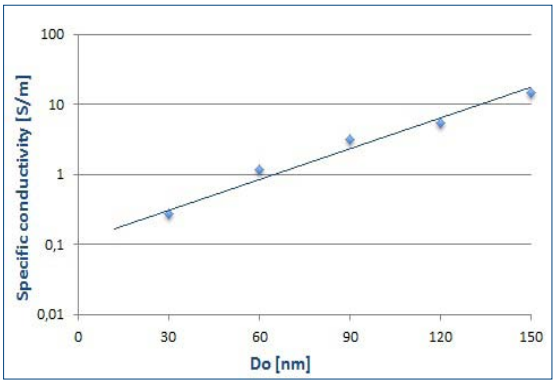
Resistance measurements of AR-PC 5090.02 layers obtained after spin deposition. For thinner films, the resistance increases and the conductivity decreases.
Process parameters 工艺参数

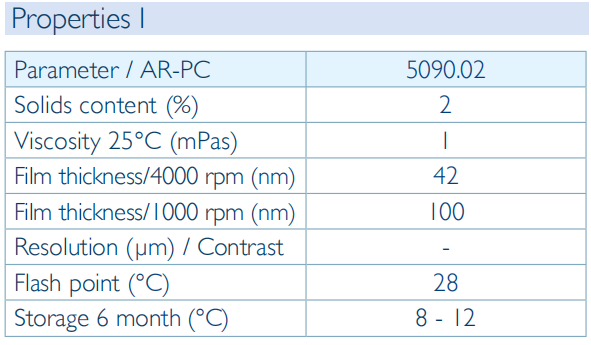
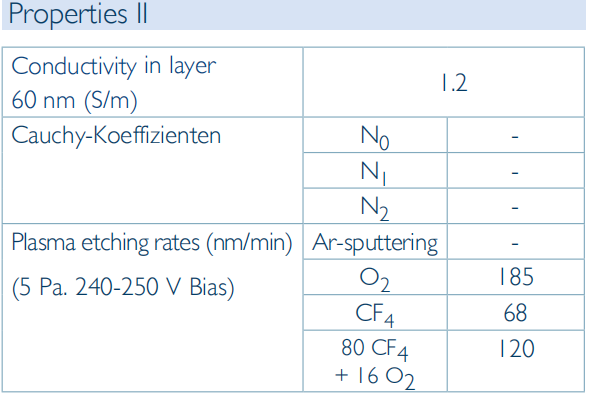
REM dissipation of charges
200 nm-squares written on quartz without distortion caused by charges with AR-P 662.04 and AR-PC 5090.02

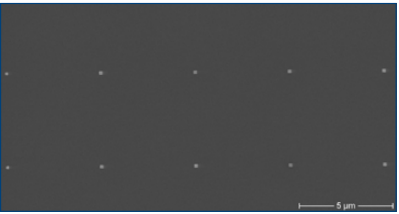
Protective Coating PMMA Electra 92 (AR-PC 5090)
Process conditions
This diagram shows exemplary process steps for resist Electra 92 - AR-PC 5090.02 and PMMA-resist AR-P 664.04.
All specifications are guideline values which have to be adapted to own specific conditions.
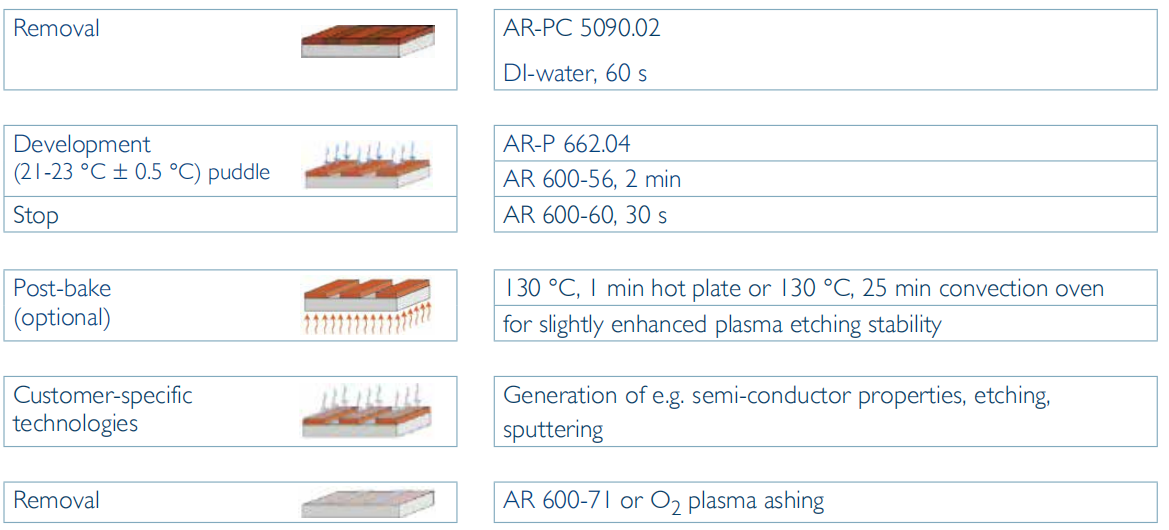
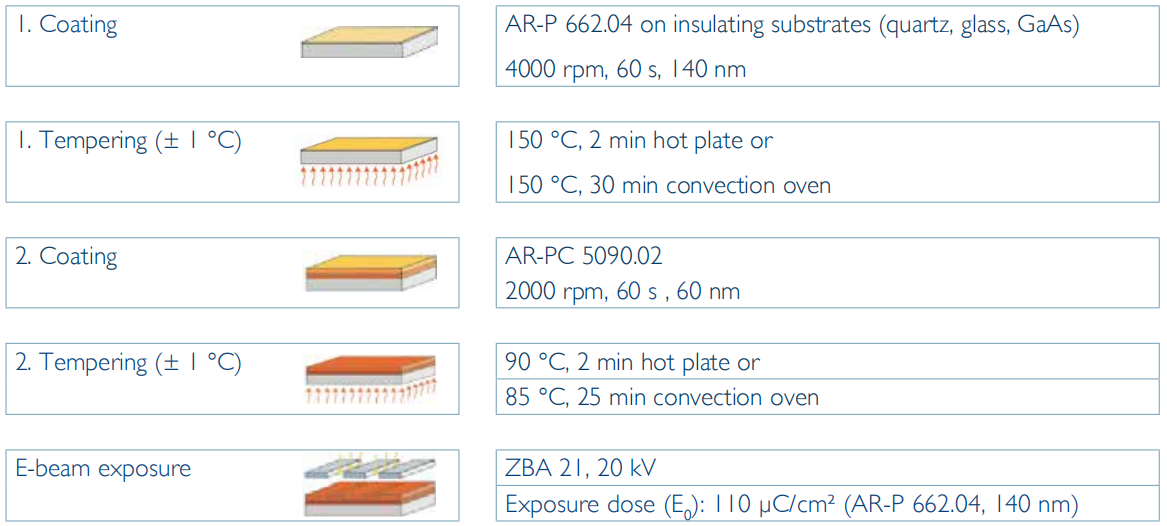
Processing instructions
The conductivity may be varied by adjusting the thickness with different rotational speeds. Thicker layers of 90 nm thus have a 2.5 times higher conductivity as compared to 60 nm thick layers.
For the build-up of an even conductive layer, the substrate should be wetted with the resist solution before the spin process is started.
Protective Coating Novolac Electra 92 (AR-PC 5091)
Conductive protective coating for novolac-based e-beam resists
Top layer for the dissipation of e-beam charges on insulating substrates
Characterisation
- as protective coating, this resist is not sensitive to light / radiation
- thin, conductive layers for the dissipation of charges during electron exposure
- coating of novolac-based e-beam resist AR-N 7000
- longterm-stable and cost-efficient alternative to Espacer
- easy removal with water after exposure
- polyaniline-derivative dissolved in water and IPA
Conductivity
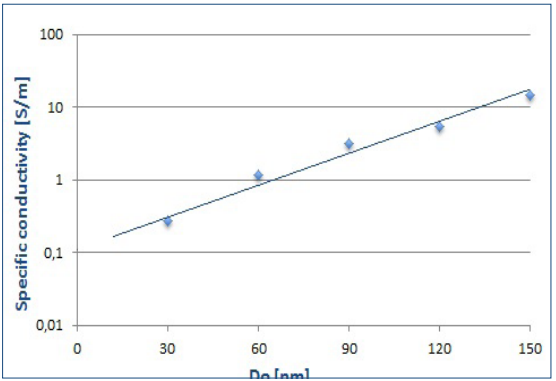
Resistance measurements of AR-PC 5091.02 layers obtained after spin deposition. For thinner films, the resistance increases and the conductivity decreases.
Note: Novolac-based e-beam resists possess other surface properties than CSAR 62 or PMMA. AR-PC5091 was thus developed with a different solvent mixture. In all other respects however, the polymer composition of AR-PC 5090 and AR-PC 5091 is identical so that both resists are referred to as “Electra 92“.
Process parameters
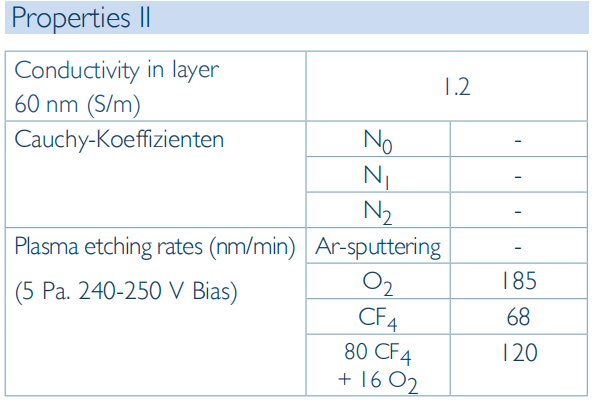
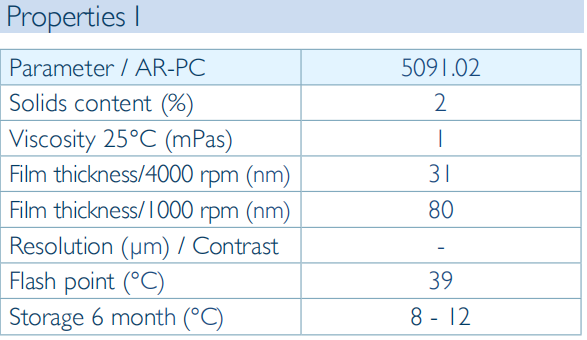

REM dissipation of charges
50 nm lines written on glass at a pitch of 150 nm with AR-N 7520.07 and AR-PC 5091.02
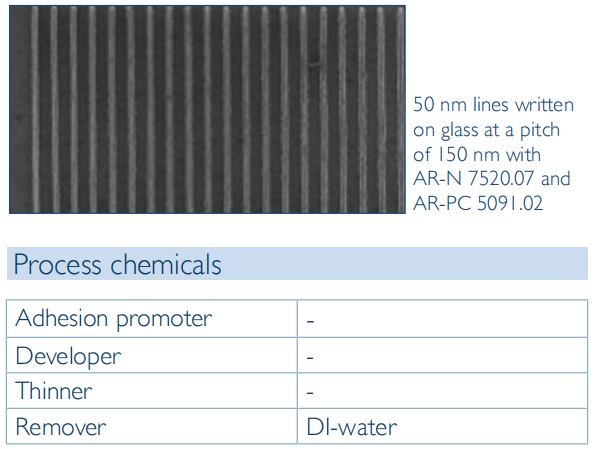
Protective Coating Novolac Electra 92 (AR-PC 5091)
Process conditions
This diagram shows exemplary process steps for resist Electra 92 (AR-PC 5091.02) and e-beam resist AR-N 7520.07neu. All specifications are guideline values which have to be adapted to own specific conditions.

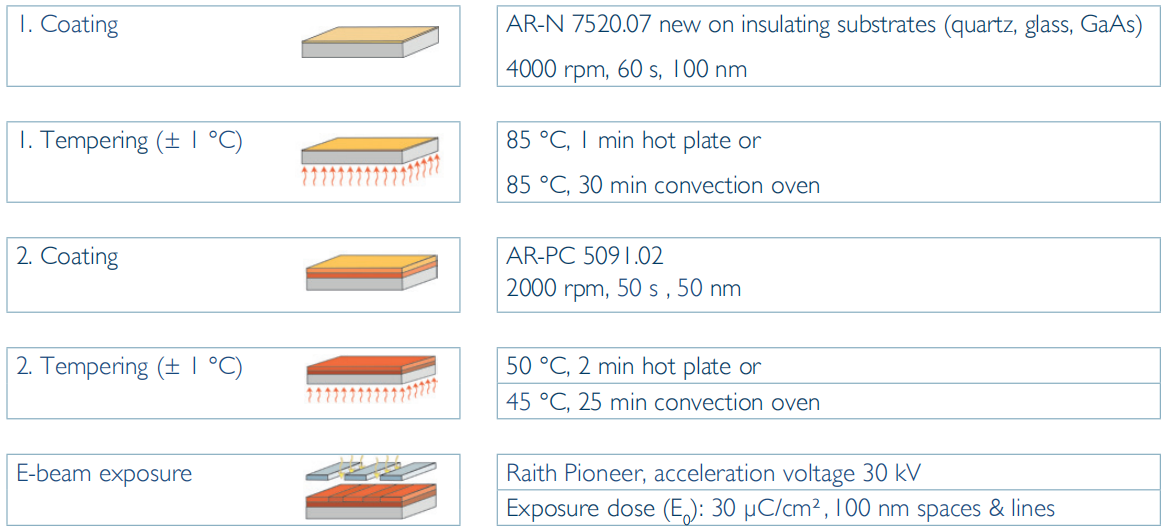
Processing instructions
The conductivity may be varied by adjusting the thickness with different rotational speeds. Thicker layers of 90 nm thus have a 2.5 times higher conductivity as compared to 60 nm thick layers. In the case that crack formation is observed after tempering of the protective coating, the tempering step can be omitted.
For the build-up of an even conductive layer, the substrate should be wetted with the resist solution before the
spin process is started.
Protective Coating Electra 92
Application examples for PMMA-Electra 92
Shelf live of Electra 92
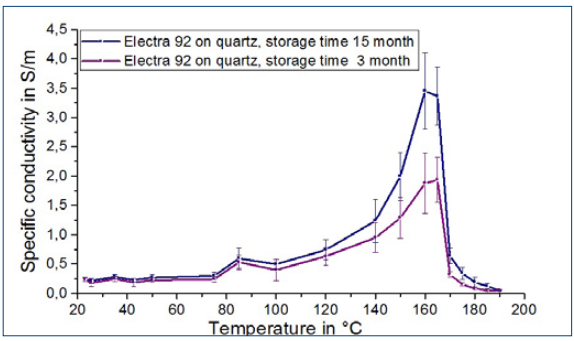
Conductivity properties of differently aged Electra 92 batches
The conductivity was determined as a function of the measured temperature. At temperatures < 100 °C, both resists show a virtually identical conductivity. Electra 92 is thus characterised by a very long shelf life. Conductivity measurements up to a temperature of 160°C which were performed directly on a hotplate showed a large increase of the conductivity by a factor of 10 (see diagram). This fact is due to the complete removal of water from the layer. After a few hours of air humidity absorption under room conditions, the conductivity decreases again to
the initial value. In the high vacuum of e-beam devices, the water is also completely removed and the conductivity thus increases accordingly. This effect has been demonstrated in direct conductivity measurements under mediate vacuum conditions. Temperatures above 165 °C destroy the polyaniline irreversibly and no conductivity is observed any more
CSAR 62 on glass with Electra 92 for deriving
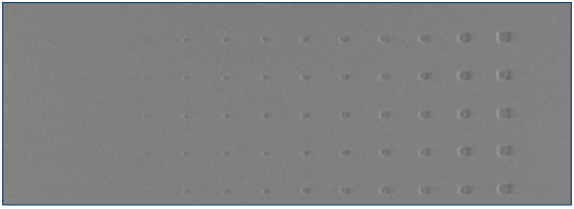
30 – 150 nm squares of CSAR 62 on glass
The combination of CSAR 62 with Electra 92 - AR-PC5090.02 offers the best options to realise complex ebeam structuring processes on glass or semi-insulating substrates like e.g. gallium arsenide. The excellent sensitivity and highest resolution of the CSAR are complemented harmoniously by the conductivity of Electra 92.
CSAR 62 and Electra 92 on glass
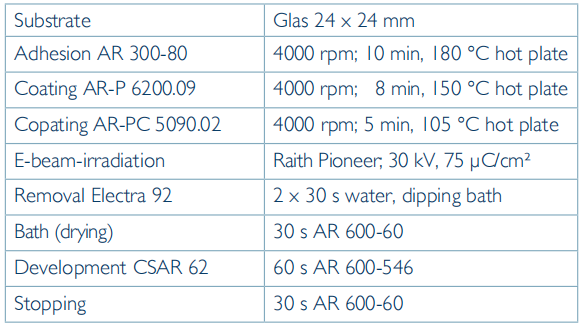
At a CSAR 62 film thickness of 200 nm, squares with an edge length of 30 nm could reliably be resolved on glass.
PMMA Lift-off on glass with Electra 92

200 nm squares produced with 2-layer PMMA lift-off
Initially, the PMMA resist AR-P 669.04 (200 nm thickness) was coated on a quartz substrate and tempered. The se cond PMMA resist AR-P 679.03 was then applied (150nm thickness) and tempered, followed by coating with Electra 92. After exposure, Electra 92 was removed with
water, the PMMA structures were developed (AR 600-56) and the substrate vaporised with titanium/gold. After a liftoff with acetone, the desired squares remained on the glass with high precision.
PMMA-Lift-off auf Glas mit Electra 92
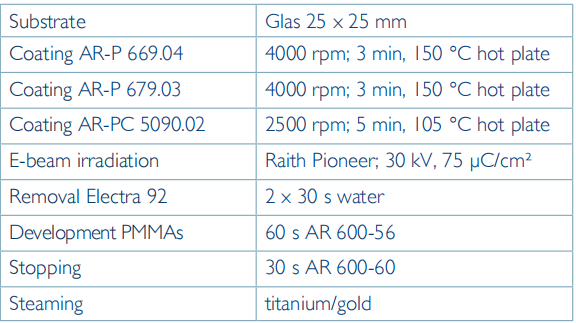
Protective Coating Electra 92
Application examples for PMMA Electra 92
Electra 92 with HSQ on quartz

20 nm bars of HSQ, prepared on quartz AR-PC 5090.02
After a coating of Electra 92 on an HSQ resist, even this resist can be patterned on a quartz substrate with very high quality. The HSQ resist (20 nm thickness) was irradiated with the required area dose of 4300 µC/cm².
SX AR-PC 5000/90.2 was subsequently completely removed within 2 minutes with warm water and no residues could be detected. After development of the HSQ resist, the structures with high-precision 20 nm bars remained.
Lift-off struktures on garnet
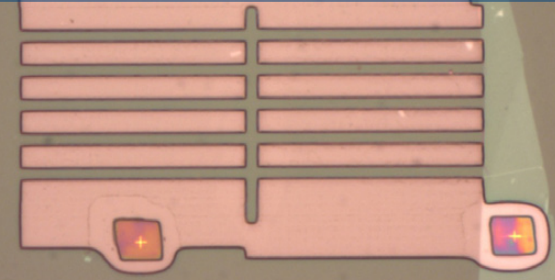
Lift-off structures on garnet (University of California, Riverside,Department of Physics and Astronomy)
Plasmonic structures on quartz
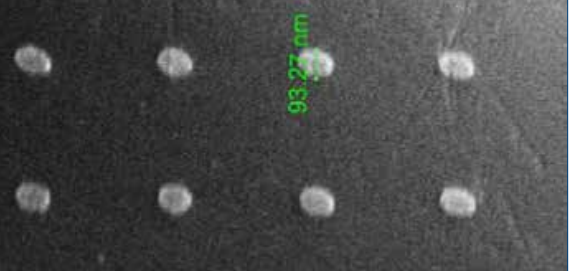
Silver nanoparticles on quartz, generated with AR-P 672.11 and ARPC 5090.02 (Aarhus University, Denmark)
Application examples for Novolac Electra 92
Electra 92 and AR-N 7700 on glass
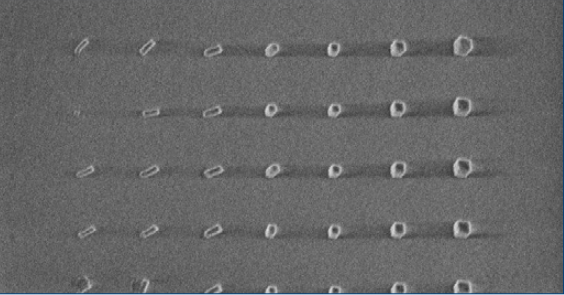
60 – 150 nm squares (100 nm height) on glass with AR-N 7700.08 and AR-P 5091.02
Novolac-based e-beam resists possess other surface properties than CSAR 62 or PMMA. For this reason, AR-PC5091.02 was designed with a different solvent composition. E-beam resist AR-N 7700.08 was at first spincoated on glass, dried, coated with Electra 92 and baked at 50 °C. After irradiation, the Electra layer was removed within 1 minute with water and the e-beam resist then developed. The resulting resolution of 60 nm is very high for chemically amplified resists.
产品优势
德国ALLRESIST防护涂层PMMA Electra 92 (AR-PC 5090)
用于非氮基电子束电阻的导电保护涂层
用于在绝缘衬底上耗散电子束电荷的顶层
用于非氮基电子束电阻的导电保护涂层
用于在绝缘衬底上耗散电子束电荷的顶层
- 产品分类
- 品牌分类
- 光刻机/3D打印机/电子束直写仪
- 镀膜沉积系统
- 离子刻蚀与沉积系统
- 匀胶涂覆系统
- 半导体辅助工艺/光刻胶
- 半导体微纳检测仪
- 实验检测仪器
- 太阳能检测仪
- 紫外线UV光清洗/等离子清洗
- 晶圆贴片/贴膜/UV解胶机/晶圆清洗机
- (荷兰)荷兰TSST
- (英国)英国Durham Magneto Optic
- (德国)德国Finetech
- (日本)日本AND
- (日本)日本Tohuko
- (瑞典)瑞典Mycronic
- (日本)日本理音
- (美国)美国KLA
- (美国)美国D&S
- (瑞士)瑞士Swisslitho AG
- (德国)德国MBE-Komponenten
- (美国)美国RTI
- (英国)英国牛津真空
- (日本)日本电子
- (德国)德国UniTemp
- (美国)美国Nanovea
- (美国)美国德龙
- (日本)日本尼康
- (美国)湖岸LakeShore
- (美国)美国SONIX
- (德国)德国YXLON
- (美国)美国OAI
- (美国)美国阿兹特克
- (美国)美国Royce
- (美国)美国OGP
- (美国)美国相干
- (深圳)杰普特
- (美国)美国Filmetrics
- (美国)美国Thorlabs
- (美国)美国nanoArch
- (英国)英国Quorum
- (美国)美国Anasazi
- (美国)美国Montana Instruments
- (芬兰)芬兰Picosun
- (土耳其)土耳其ADLEMA
- (苏州)苏州纽迈
- (法国)法国Alyxan
- (英国)英国NanoBeam
- (德国)德国YXLON
- (德国)德国neaspec
- (瑞典)瑞典NanOsc
- (德国)德国Sentech
- (德国)德国Attocube Systems
- (东莞)庆达VIPUV
- (英国)英国HHV
- (德国)德国耐驰
- (英国)NanoMagnetics
- (法国)法国Plassys
- (美国)美国Associated Research
- (日本)日立
- (英国)牛津仪器
- (德国)德国克吕士
- (美国)美国SCIEX
- (美国)美国Denton Vacuum
- (日本)日本SEN
- (美国)美国海马
- (德国)德国iplas
- (美国)美国Jelight
- (美国)美国Sinton Instruments
- (美国)美国Nano-Master
- (美国)美国novascan
- (美国)美国Neocera
- (美国)美国Trion
- (美国)美国UVOCS
- (成都)中科院
- (台北)台湾正恩科技
- (比利时)比利时宝镭泽
- (德国)德国Allresist
- (瑞士)瑞士Sawatec
- (德国)德国Diener
- (美国)美国AZ technology
- (美国)美国劳瑞尔
- (美国)美国Uvitron
- (英国)英国EMS
- (美国)美国MicroChem
- (德国)德国Optosol
- (深圳)深圳一正
- (德国)德国FS Bondtec
- (美国)美国Newport
- (英国)英国MML
- (美国)美国Nisene
- (美国)美国VTI
- (美国)美国FEI
- (美国)美国RKD
- (德国)德国PVA TePla
- (日本)日本理学
- (英国)英国AML
- (美国)美国PI
- (日本)富士
- (日本)日本Advance Riko
- (美国)美国Sonoplot
- (香港)托普斯
- (美国)美国Quantum Design
- (美国)美国泰德派勒
- (丹麦)丹麦NIL TECHNOLOGY
- (日本)日本RIBM
- (美国)美国SCS
- (瑞典)瑞典Obducat
- (德国)德国布鲁克
- (韩国)韩国ATI
- (德国)德国海德堡
- (日本)日本伊领科思
- (美国)赛默飞世尔
- (西班牙)西班牙Mecwins
- (德国)德国纳糯
- (德国)徕卡生物系统
- (美国)美国泰克
- (美国)美国Harrick
- (德国)德国SUSS MicroTec
- (日本)日本基恩士
- (瑞士)瑞士nanosurf
- (德国)德国ParcanNano
- (德国)德国蔡司
- (奥地利)奥地利EVG
- (美国)美国MMR
- (英国)英国牛津
- (德国)德国Raith
- (日本)日本 Ulvac
- (韩国)韩国ECOPIA
- (德国)凯斯安KSI
- (德国)德国Eulitha
- (苏州)苏州纳维科技
- (新竹)台湾智果整合
- (德国)德国Nanoscribe
- (俄罗斯)俄罗斯Optosystem
- (法国)法国Annealsys
- (德国)德国Klocke Nanotechnik
-
仪企号
 深圳市蓝星宇电子科技有限公司
深圳市蓝星宇电子科技有限公司
-
友情链接


